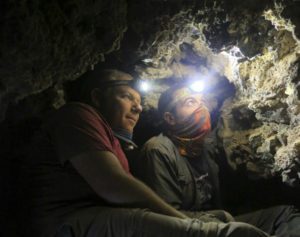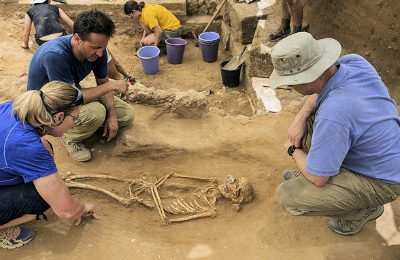QUMRAN, West Bank — Archaeologists have discovered another cave in Qumran. The discovery was made by Dr. Oren Gutfeld and Ahiad Ovadia from the Hebrew University of Jerusalem’s Institute of Archaeology, with the help of Dr. Randall Price and students from Liberty University in Lynchburg, Virginia.
The excavations took place on the cliffs west of Qumran, near the northwestern shore of the Dead Sea.
“Cave 12” is the first new scroll cave to be discovered and properly excavated in over 60 years. The excavation was supported by the Civil Administration of Judea and Samaria, the Israel Nature and Parks Authority, and the Israel Antiquities Authority (IAA), and is a part of the new ‘Operation Scroll’ launched at the IAA by its Director-General, Israel Hasson, to undertake systematic surveys and to excavate the caves in the Judean Desert.
Excavation of the cave revealed that at one time it contained Dead Sea scrolls. Numerous storage jars and lids from the Second Temple period were found hidden in niches along the walls of the cave and deep inside a long tunnel at its rear.
The jars were all broken and their contents removed.
The discovery of a pair of iron pickaxe heads from the 1950s (stored within the tunnel for later use) proves the cave was looted.
Until now, it was believed that only 11 caves had contained scrolls. With the discovery of this cave, scholars have now suggested that it would be numbered as Cave 12.
Like Cave 8, in which scroll jars but no scrolls were found, this cave will receive the designation Q12, the Q indicating no scrolls were found.
“This exciting excavation is the closest we’ve come to discovering new Dead Sea scrolls in 60 years,” said Dr. Oren Gutfeld, an archaeologist at The Hebrew University and director of the excavation.
“Although no scroll was found, and instead we ‘only’ found a piece of parchment rolled up in a jug that was being processed for writing, the findings indicate beyond any doubt that the cave contained scrolls that were stolen.
“The findings include the jars in which the scrolls and their covering were hidden, a leather strap for binding the scroll, a cloth that wrapped the scrolls, tendons and pieces of skin connecting fragments, and more.”
The discovery of pottery and of numerous flint blades, arrowheads and a decorated stamp seal made of carnelian, a semi-precious stone, suggest that this cave was used in the Chalcolithic and the Neolithic periods.
“The important discovery of another scroll cave attests to the fact that a lot of work remains to be done in the Judean Desert. Finds of huge importance are still waiting to be discovered,” said Israel Hasson.















